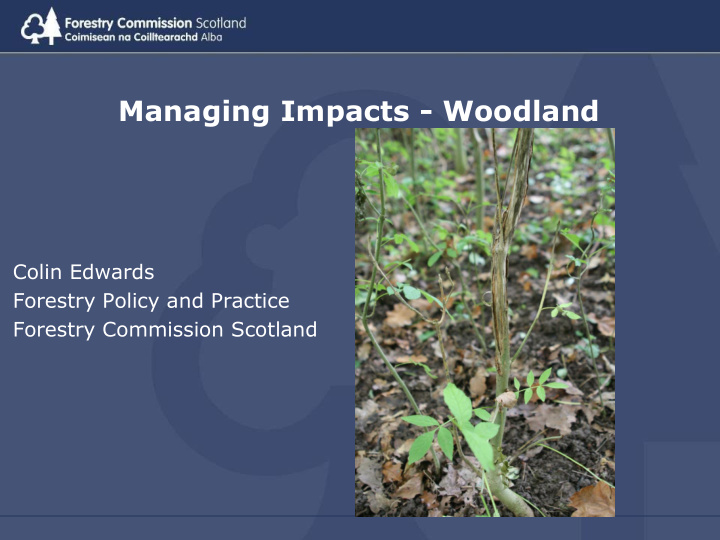



Managing Impacts - Woodland Colin Edwards Forestry Policy and Practice Forestry Commission Scotland
What Impacts? The native Woodland Survey of Scotland • (NWSS) identified and surveyed all native, nearly native and ancient woods over 0.5ha in size in Scotland, from 2006-12. Native woods were defined as those with • at least half the woodland canopy cover composed of native species. Herbivore Impact score was based on an assessment of: • ‘browsing rate’ for lead shoots , ‘browse line’, ‘browsing of basal and • epicormic shoots ’, ‘ bark stripping and fraying ’, and ‘ shrubs – preferentially browsed’. ‘ grazed sward and ‘ poached ground ’. Information was later analysed to assign each polygon a herbivore impact • rating on a 4 point scale (Low, Medium, High, and Very High). The main herbivores thought responsible were recorded where known. • 2 of 6 Managing Impacts - Woodland
What Impacts? The medium impact • rating (B) was found in just over half of all native woods… …this means some regeneration will be able to • occur, but more vulnerable tree species may not. …floral species diversity may be restricted. • Combined this will reduce the overall biodiversity • value of the woodland. 3 of 6 Improving Native Woodland Condition
Next steps - FCS are developing our Native Woodlands Project . Objectives: is to better co-ordinate FCS efforts to deliver the FCS priority “to improve the extent and condition of Native woodlands”. 4 of 6 Improving Native Woodland Condition
Availability of information NWSS provides freely available spatial data , which can be used at any scale and for many purposes: including location of woodlands with high or very high herbivore impacts. Regional Reports. online Map Viewer allows data download site provides Survey results in published users to view and explore the full survey dataset for format. native woodland locations Geographical Information and attribute data at a Systems (GIS) users, currently variety of scales. in Esri shapefile format . 5 of 6 Managing Impacts - Woodland
Management Options FCS supports deer groups, land managers and private forestry sector • to improve native woodland condition, particularly through the integration of deer management plans and Long Term Forest Plans. A Woodland Improvement Grant provides funding for the collection • of appropriate data to develop Deer Management Plans. FCS provides grant assistance for deer management in support of • woodland creation and woodland management objectives. The aim of the grant is to reduce deer impacts to a level that will allow the: regeneration of unprotected tree species at a landscape scale; to help diversify forests; and improve their conservation value. The forestry grant (Reducing Deer Impact) is available through the • Scottish Rural Development Programme 6 of 6 Managing Impacts - Woodland
Recommend
More recommend